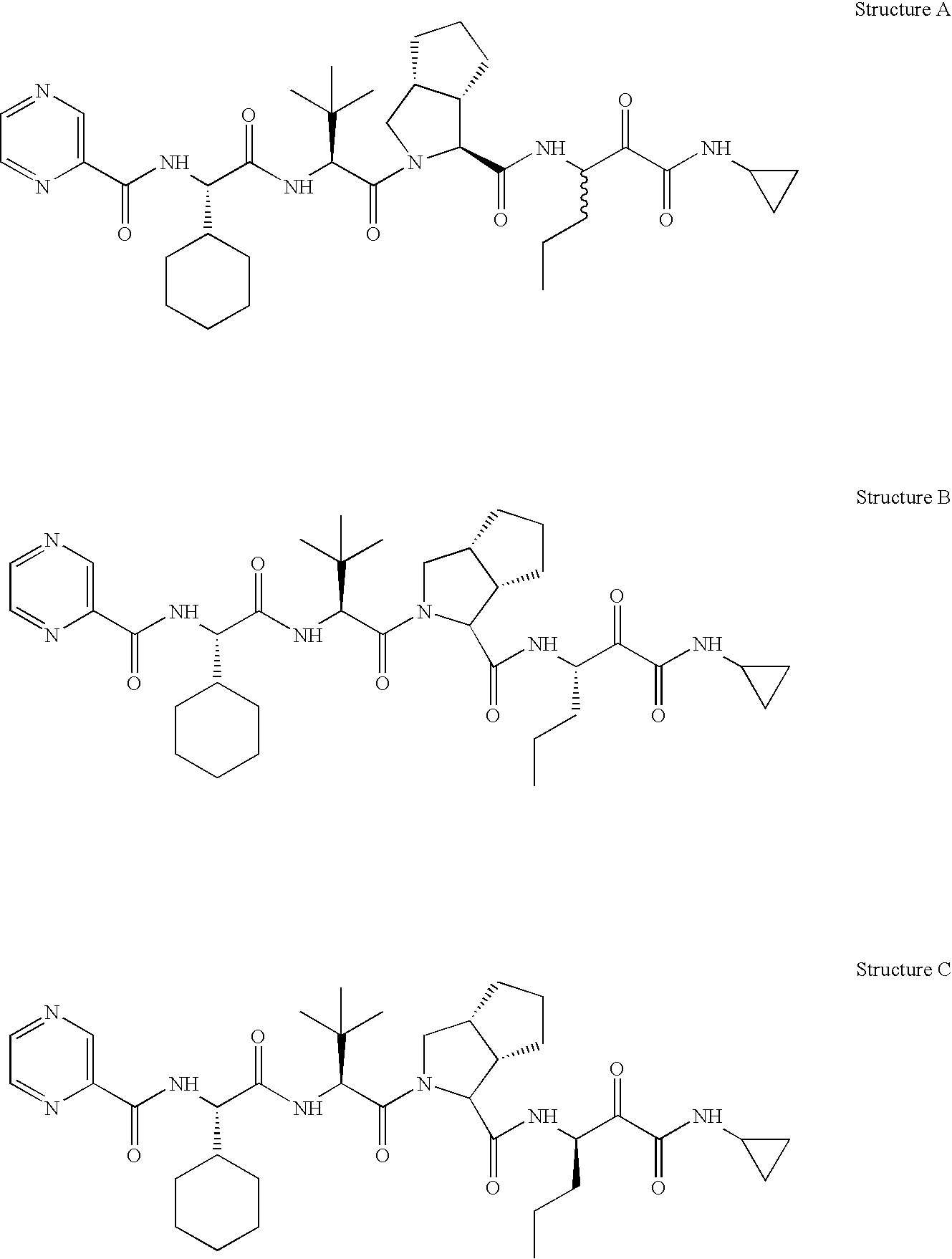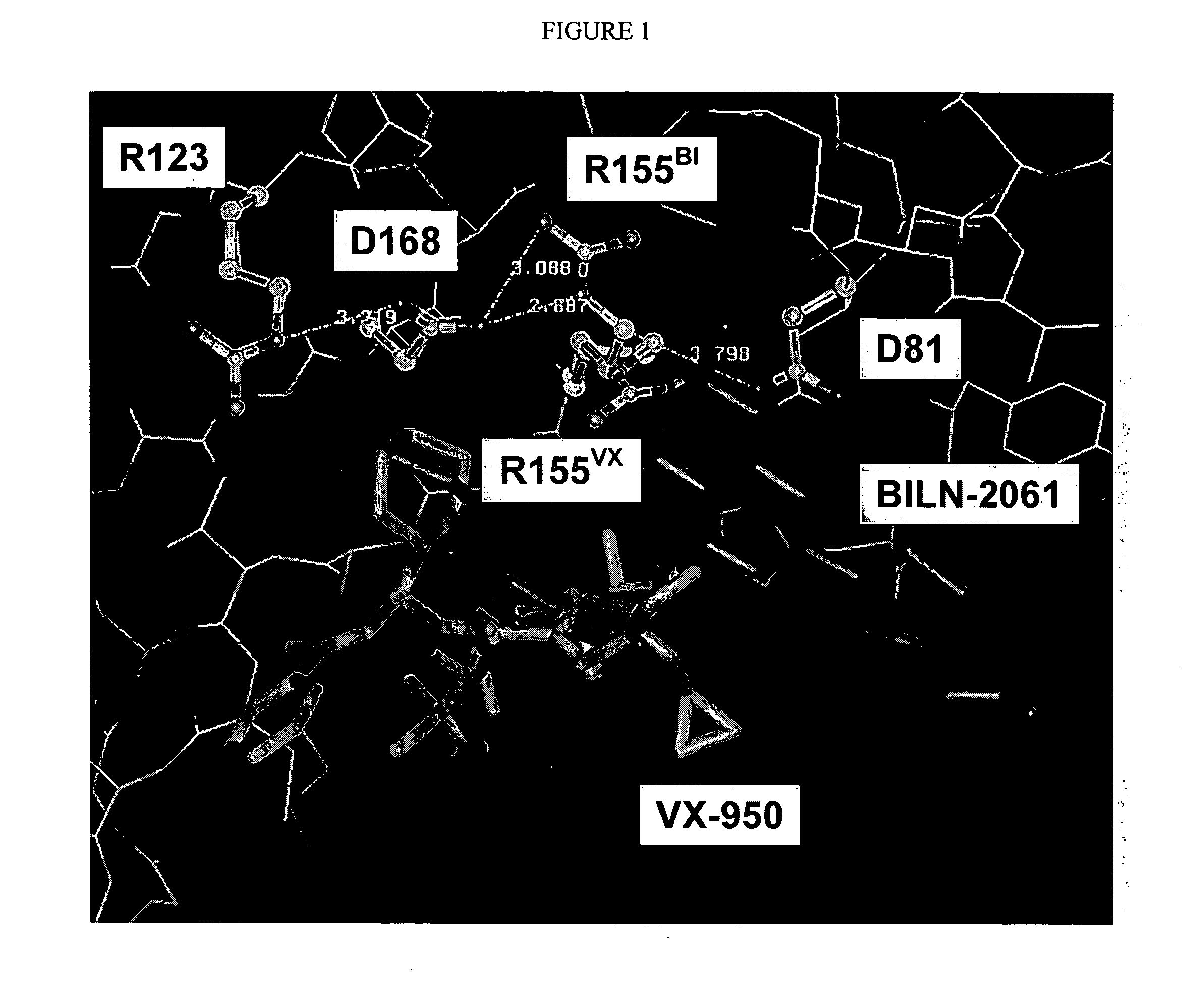NS3-NS4A protease resistance mutants
a technology of ns3 and ns4a, which is applied in the field of resistance mutants of hepatitis c virus ns3/4a protease, can solve the problems of inability to broadly effective treat the debilitating progression of chronic hcv, hcv has not led to satisfactory anti-hcv agents or treatments, and the prospects for effective anti-hcv vaccines remain uncertain
- Summary
- Abstract
- Description
- Claims
- Application Information
AI Technical Summary
Benefits of technology
Problems solved by technology
Method used
Image
Examples
example 1
Construction of Plasmids
[0207] A DNA fragment encoding residues Ala1-Ser181 of the HCV NS3 protease (GenBank CAB46913) was obtained by PCR from the HCV Con1 replicon plasmid, I377neo / NS3-3′ / wt (re-named as pBR322-HCV-Neo in this study) [V. Lohmann et al., Science, 285, pp. 110-113 (1999)] and inserted into pBEV11 (S. Chamber, et al., personal communication) for expression of the HCV proteins with a C-terminal hexa-histidine tag in E. coli. Resistance mutations against the HCV NS3•4A PI were introduced into this construct by PCR-based, site-directed mutagenesis. To generate the HCV replicon containing the PI-resistant mutations, a 1.2-kb Hind III / BstX I fragment derived from the HCV Con 1 replicon was sub-cloned into a TA cloning vector, pCR2.1 (Invitrogen). The PI-resistant mutations in the NS3 serine protease domain were introduced into the pCR2.1 vector containing the Hind III / BstX I HCV fragment by PCR, and a 579-bp BsrG I / BstX I fragment containing the mutated residue was sub-c...
example 2
Generation of HCV Replicon Cells
[0208] The Con1 sub-genomic replicon plasmid pBR322-HCV-Neo [Lohmann et al., Science, 285, pp. 110-113 (1999)] was digested with Sca I (New England Biolabs). Full-length HCV sub-genomic replicon RNA was generated from the linearized DNA template using a T7 Mega-script kit (Ambion) and treated with DNase to remove the template DNA. The run-off RNA transcripts were electroporated into Huh-7 cells and stable HCV replicon cell lines were selected with 0.25 or 1 mg per ml G418 (Geneticin) in Dulbecco's modified minimal essential medium (DMEM) containing 10% fetal bovine serum (FBS). HCV replicon stable cells were maintained in DMEM, 10% FBS and 0.25 mg per ml G418.
[0209] During the course of generating of the HCV sub-genomic replicon stable cell lines, several different patterns of adaptive mutations were identified. One pattern has three substitutions in the HCV nonstructural proteins, which were introduced into the original pBR322-HCV-Neo plasmid by si...
example 3
HCV Replicon Cell Assay Protocol
[0210] Cells containing hepatitis C virus (HCV) replicon were maintained in DMEM containing 10% fetal bovine serum (FBS), 0.25 mg per ml of G418, with appropriate supplements (media A).
[0211] On day 1, replicon cell monolayer was treated with a trypsin:EDTA mixture, removed, and then media A was diluted into a final concentration of 100,000 cells per ml wit. 10,000 cells in 100 ul were plated into each well of a 96-well tissue culture plate, and cultured overnight in a tissue culture incubator at 37° C.
[0212] On day 2, compounds (in 100% DMSO) were serially diluted into DMEM containing 2% FBS, 0.5% DMSO, with appropriate supplements (media B). The final concentration of DMSO was maintained at 0.5% throughout the dilution series.
[0213] Media on the replicon cell monolayer was removed, and then media B containing various concentrations of compounds was added. Media B without any compound was added to other wells as no compound controls.
[0214] Cells...
PUM
| Property | Measurement | Unit |
|---|---|---|
| Composition | aaaaa | aaaaa |
| Structure | aaaaa | aaaaa |
| Electrical resistance | aaaaa | aaaaa |
Abstract
Description
Claims
Application Information
 Login to View More
Login to View More - R&D
- Intellectual Property
- Life Sciences
- Materials
- Tech Scout
- Unparalleled Data Quality
- Higher Quality Content
- 60% Fewer Hallucinations
Browse by: Latest US Patents, China's latest patents, Technical Efficacy Thesaurus, Application Domain, Technology Topic, Popular Technical Reports.
© 2025 PatSnap. All rights reserved.Legal|Privacy policy|Modern Slavery Act Transparency Statement|Sitemap|About US| Contact US: help@patsnap.com



